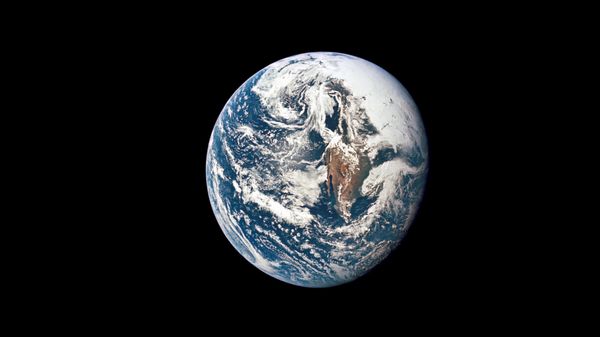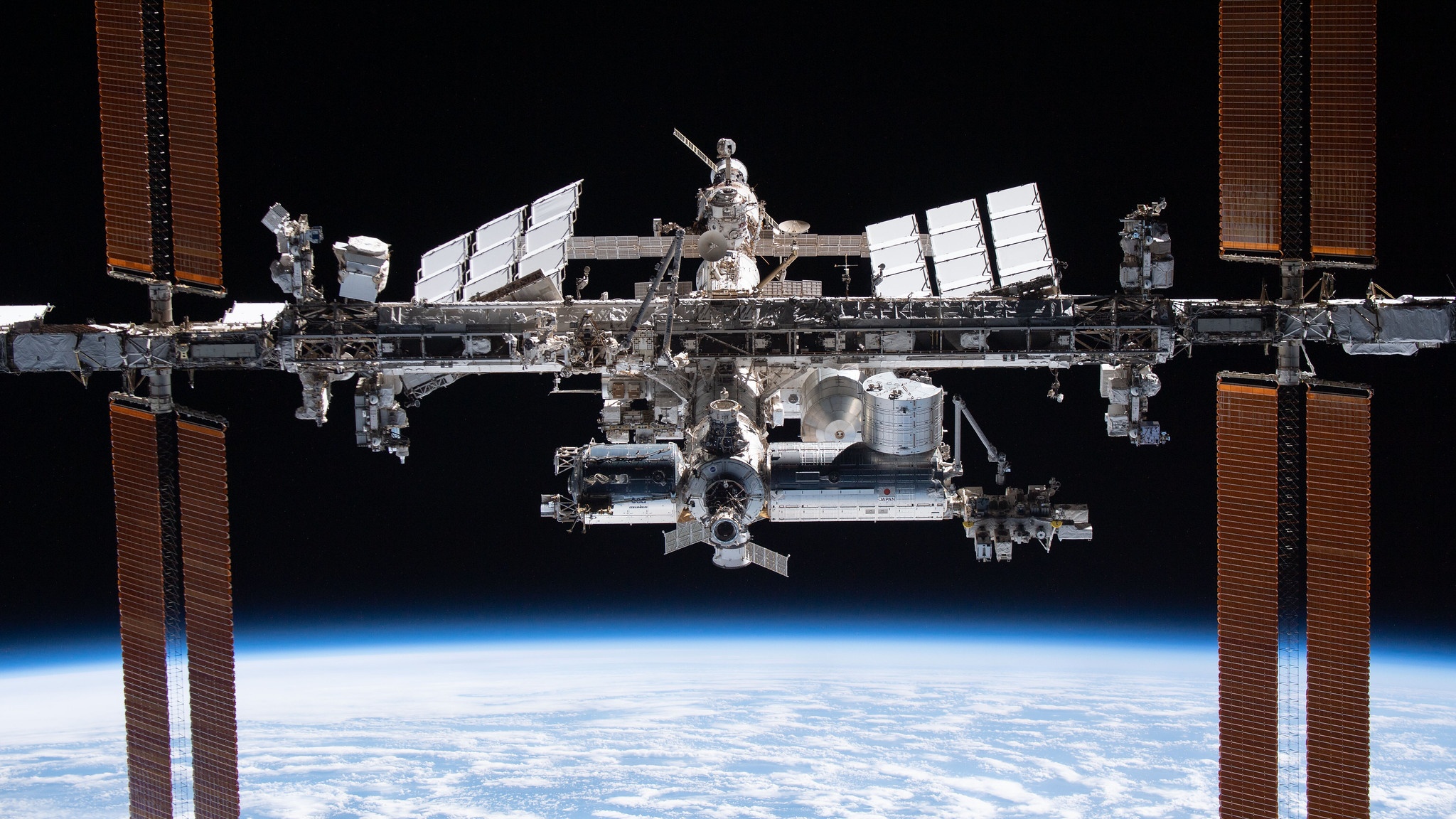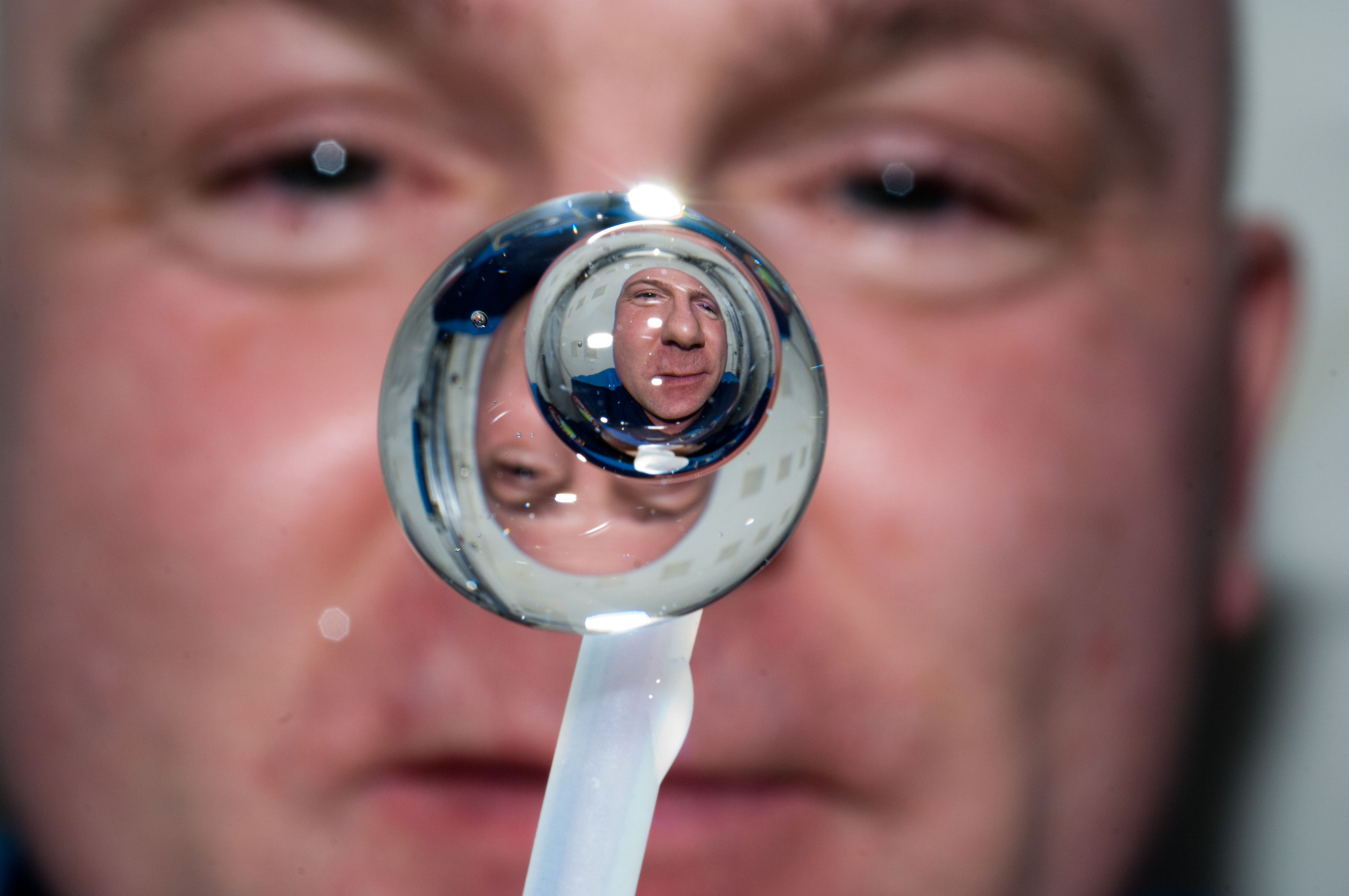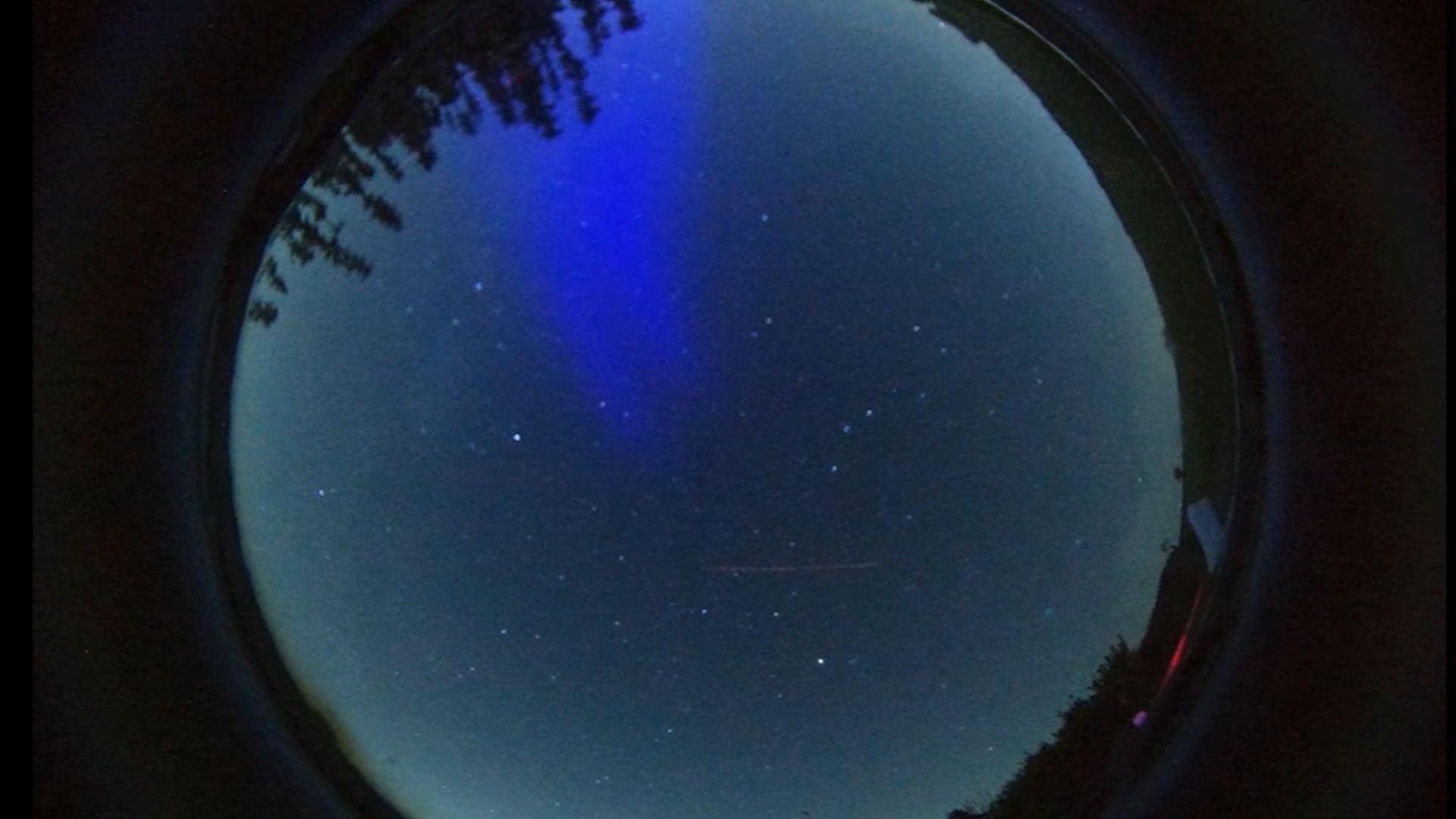Earth is a spaceship like the ISS — let me explain
The environments in space habitats and on the Earth are both closed-loop systems, only on vastly different scales.

Imagine living in a place where your survival depends upon living within your limits, not consuming more food and energy than you produce, creating enough fresh water and air to live on, reducing waste to a bare minimum, recycling everything that you can, and avoiding contaminating the environment around you. This is what astronauts must face, to an extent, on board the International Space Station, and what they would have to face to a greater extent in future settlements on the moon or Mars.
But it's also how we have to live on Earth if we are to protect our environment, which is one of the themes of this year's World Space Week, running between Oct. 4 to Oct. 10.
A space station, or a lunar base, is largely a closed-loop system. What we mean by this is that it must produce its own resources and then recycle them, feeding them back into the system because they are limited. Consume too much, and astronauts might run out of air, food, water or energy, which could be fatal. Sure, there are occasional resupplies from Earth, however, so they are not 100% closed loop systems. What is a completely closed loop, however, is Earth itself.
Spaceship Earth
Think about it. Our planet has a certain carrying capacity, or what the Club of Rome — a think-tank of academics, business leaders and politicians — called the "limits to growth" in their famous 1973 report. They warned that Earth was beginning to reach its carrying capacity, and soon we would be generating too much energy, eating too much food, not producing enough fresh water, and pouring greenhouse emissions into the atmosphere that would render our global closed-loop system unsustainable. Indeed, as climate change grows increasingly more damaging year upon year, leading to more frequent droughts, famines, wildfires and extreme weather, some might say we have already reached that stage.
Related: How satellite data has proven climate change is a climate crisis
This is where learning to live in space can help teach us how to live sustainably on Earth. It's not a new idea, but a recent paper by researchers at the German Aerospace Center in the journal Sustainable Earth Reviews succinctly summed up how technologies designed for living in closed-loop space habitats can be applied to Earth.
They described how a space habitat must fulfill several functions in order to remain a closed-loop system, and how each of these can be re-applied to the larger scale of the Earth.
Get the Space.com Newsletter
Breaking space news, the latest updates on rocket launches, skywatching events and more!
First, resources must be cultivated and fed into the system. In this case, resources means anything and everything that a habitat requires to function, from food to energy. This concept has to be managed carefully, however, because left unchecked it is open to exploitation. For example, if all the water-ice is mined from the lunar regolith too quickly, then there would be none left to supply a lunar base for very long.
Second is the recycling of those resources so they don't get used up too quickly. In a closed-loop habitat, unrecycled waste is costly and can diminish the habitat over time because it means there is progressively less of any given resource to go around. It can also pollute the environment of the habitat, again diminishing it.
Third is self-sufficiency. Barring the occasional resupply from Earth, a space habitat needs to be able to produce and repair everything that it needs.

Finally, a closed-loop habitat must be resilient enough to support its crew and any other animal or plant life, indefinitely. If the system breaks down because it is being abused, the lifespan of the habitat becomes severely reduced.
We can see how each of these can be applied to Earth. Intensive farming, mining, fishing and so on shows how we are exploiting the cultivation of resources in our closed-loop Earth. Recycling can help us maintain our resources without fouling the environment with waste. If communities can become more self-sufficient, then carbon dioxide emissions can be reduced because resources are not having to be transported to communities from external regions.
Earth has shown resilience for life for almost four billion years, but our careless approach to the environment by overconsumption is testing that resilience.
Space on Earth
Interestingly, technologies developed for use in space can also help on Earth.
A classic example is solar panels. Invented back in 1954, during the era of coal-fired power stations, solar panels weren't exactly all the rage because there wasn't much use for photovoltaic cells on Earth at the time. Rather, solar panels first got their breakthrough in space, providing power for satellites as early as 1958 with the Vanguard 1 satellite. The amount of money that space-faring nations were able to pour into R&D for solar cells meant that, by the 1970s, those cells were capable enough to be used on Earth. Today, we find solar cells everywhere, the average panel producing 1.5 kilowatts of electricity each day; and, as of 2023 solar power generates a total of 5.5% of the world's electricity without the harmful emissions of coal-fired power stations or the toxic waste of nuclear fission reactors.
Another technology developed in space that can help support a more sustainable way of living on Earth are food-based. Crops are being grown by astronauts on the International Space Station.
The experiment, known as the Vegetable Production System, first produced lettuce in 2021, which was harvested by NASA astronaut Michael Hopkins. The experiment revolves around planting seeds in a "seed pillow" along with the controlled release of fertilizer and clay and the use of specially designed LED lights to promote photosynthesis, emitting more red and blue light that encourages plant growth. These lights are now being adapted for "vertical farming" on Earth, which is a sustainable way of growing crops that don't take up too much land in urban areas and recycle their water, just like on the space station. By growing food in vertical farms close to built-up communities, humans can cut down on transport costs and intensive farming, both of which produce high carbon dioxide emissions.
The water cycle
Speaking of water, it is paramount that water is recycled on the space station, because its weight means that it is costly to bring up from Earth. All the water on the International Space Station is recycled through a water recovery system, as part of the station's Environmental Control and Life Support System, that can turn water vapor humans breathe out into the air, sweat and even urinate into drinking water (which apparently, astronauts claim, tastes quite good!). The Urine Processor Assembly employs vacuum distillation to extract clean water from astronaut pee, leaving behind a yucky-sounding "urine brine." A Brine Processor Assembly has even been developed because usable water is still present in this brine — in a closed-loop system, every resource has to be utilized to its fullest extent.
Although we don't need to drink water from urine on Earth, there are many locations around the globe where fresh, clean water is in short supply. NASA's water recovery technology has been licensed to companies to make portable filters that allow communities to obtain clean water from contaminated supplies.

Carbon cleaning
Along with water vapor, astronauts breathe out carbon dioxide.
The astronauts on Apollo 13 learned, first-hand, the dangers of carbon dioxide build-up when they had to hurriedly build a carbon-dioxide filter out of spare parts on their way home from the moon. On the International Space Station, carbon dioxide must be similarly scrubbed out of the air.
Previously, oxygen was produced on the ISS by a system that extracted it from 400 liters of water brought up from Earth each year. Therefore, it was not a closed-loop system. Now, the European Space Agency has developed the Advanced Closed Loop System (ACLS) that is able to recycle 50% of the carbon dioxide on the station into oxygen and no longer necessitates that large amounts of water be brought up from Earth. The ACLS's Carbon dioxide Reprocessing Assembly mixes hydrogen and carbon dioxide extracted from the air to produce water and methane. The methane is vented into space as waste, but an Oxygen Generation Assembly is able to split the water into oxygen and hydrogen, the latter of which goes back into the ACLS system to begin the cycle again.
However, prior to the ACLS, carbon dioxide was removed exclusively via a mineral called zeolite, which has pores small enough to trap carbon dioxide molecules in, then flush them into space. Now, Stefano Brandani and Giulio Santori of the University of Edinburgh are exploring ways of using the zeolite technology to reduce carbon dioxide in Earth's atmosphere. They envisage giant fans sucking in air filled with carbon dioxide towards stations made from beds of zeolite that remove the carbon dioxide from the air. The same technology could also be used nearer the source, removing carbon dioxide from waste gases produced by industry before they are released into the atmosphere. Although it cannot remove all the carbon dioxide from the atmosphere and prevent global warming, carbon-capture technology could help mitigate climate change and help the world stay within the target of no more than 1.5 degrees Celsius of global warming.
Given the criticism often leveled at space programs worldwide that they are expensive luxuries then money could be spent elsewhere on Earth instead, it is ironic that technology developed to help people live in space could help us live better on Earth. Of course, space travel is not environmentally friendly per se — a rocket can emit up to 300 tons of carbon dioxide per launch — but if applied correctly, the technology used in space can certainly redress the balance by helping us become a greener planet. Earth, after all, is our most incredible spaceship.
This article is part of a special series by Space.com in honor of World Space Week 2024, which ran from Oct. 4 to Oct. 10 and explored how space technology can help fill the toolboxes of climate scientists.
Join our Space Forums to keep talking space on the latest missions, night sky and more! And if you have a news tip, correction or comment, let us know at: community@space.com.

Keith Cooper is a freelance science journalist and editor in the United Kingdom, and has a degree in physics and astrophysics from the University of Manchester. He's the author of "The Contact Paradox: Challenging Our Assumptions in the Search for Extraterrestrial Intelligence" (Bloomsbury Sigma, 2020) and has written articles on astronomy, space, physics and astrobiology for a multitude of magazines and websites.
-
billslugg I don't read articles where the headline implies I'm an idiot. I have a wife who reminds me.Reply -
Unclear Engineer I notice the financial costs of running the Earth like a space station are not mentioned at all.Reply
We have, or at least had, a functioning ecosystem that we did not have to run for ourselves. But, we have severely damaged it, if not already destroyed it, by increasing our population beyond the "carrying capacity" where what we use gets naturally recycled to let us use it again.
And, it was resilient, before we killed so much of the natural vegetation and animals. Now we can no longer "live off the land" in its natural state. We must have farming of vegetable and animal foods to sustain our large population. Which displaces the natural system. And, is more sensitive to disruptions. And costs more energy per person. -
Unclear Engineer Reply
Bill, somebody has to read them to set the record straight. Maybe ask your wife to do it for us?billslugg said:I don't read articles where the headline implies I'm an idiot. I have a wife who reminds me. -
A J Foster Reply
I do not believe that the cost is a prime point. The real cost is the survival of this planet. We already have triple the number of people onboard and that cost already spent is the trees and grass needed to filter the air we require to exist. With the population we have,the housing needed and the number of factories and covered parking areas and paved roadways already required to provide the comforts and leisures we believe we need exceeds the ability to maintain balance. In my lifetime I have seen the world population of 2.2 billion raise to today 8.2 billion. That is 4 times in 90 years. That is not sustainable at our rate of breeding we will exhaust our planet's ability to maintain liveability. What to do is up to the present population to decide if we will live or die: decide now or all is lost.Unclear Engineer said:I notice the financial costs of running the Earth like a space station are not mentioned at all.
We have, or at least had, a functioning ecosystem that we did not have to run for ourselves. But, we have severely damaged it, if not already destroyed it, by increasing our population beyond the "carrying capacity" where what we use gets naturally recycled to let us use it again.
And, it was resilient, before we killed so much of the natural vegetation and animals. Now we can no longer "live off the land" in its natural state. We must have farming of vegetable and animal foods to sustain our large population. Which displaces the natural system. And, is more sensitive to disruptions. And costs more energy per person. -
Mars Tafts I don't see the ISS as a closed system. Without frequent resupply any habitat therein would soon expire.Reply
As for the earth, yes it is a spaceship and we are, in Zefram Cochran's words "all astronauts on some kind of star trek. -
Unclear Engineer I agree with you point about population expansion. The problem is how to get people to stop it. The economists like to point out that birth rates fall below replacement levels in "developed" countries. But, they fail to note that the populations of those countries still keep increasing due to in-migration. People in less developed countries, and the poor is some developed countries, do reproduce substantially faster than replacement - and then go to the developed countries "for opportunities".Reply
So, it seems very questionable if we can make enough "development fast enough ro everybody to be happy enough where they are born to stay there and not increase their populations. Or, will the population increase faster than we can pull people up out of "poverty"?
So far, poverty seems to be winning. Which means population will probably not decrease until there are circumstances so dire that people die in large numbers, often. It would be nice if humans could learn to be smarter in a collective way. But, most seem to be focused on short-term interests, often just survival, now. -
Atlan0001 Constructing artificially gravitied stations and colonies is the one and only way to open the Space Frontier to hundreds and thousands and millions and billions and breakout in expansion from the Earth! Which is why it hasn't been done, won't be done, or allowed to be done by the totalitarian state ruling space and, therefore, ruling Earth!!!!Reply
All it will take for speed in opening the frontier is an artificial gravity beginning out there! The very equal of discovering gold!
-----------------------------
"The secret of wealth is human capital. And the secret of human capital is a work ethic that scorns sponging" . . . and scorns mass "busy work." Scorning treadmills and forced running faster and ever faster in place to 'Nowhere' (Earth and Earth orbital 'Utopia')! A meteor burning brightest on its way to ground and 'Apocalypse'! -
billslugg Artificial gravity is easily achieved through spinning. The problem is Coriolis forces but they are brought down to reasonable levels by having a large diameter. About 1000 feet is needed. This can give 1 g, which is needed for bone stability. One cannot easily make such a large diameter cylinder because the walls would have to be too thick to hold the pressure in. Only about 100 feet is reasonable, cost wise.Reply
One solution is to take existing habitats, tie them together with a 1000' long cable and get them spinning. You can add habitats and cables as needed. No limit to it. It also avoids the problem of having one single giant ecosystem that might lose its air all at once. -
Unclear Engineer Regarding rotating space stations. I don't expect to see either 1.000 foot diameter spheres (or disks) or separate modules cabled together across their mutual center of mass. I think the toroidal designs we have been seeing in fiction since the 1950s are more likely. Think "wagon wheel" with some hollow spokes to a central tube, spinning around a virtual "axle".Reply
But, if anything is spinning in space fast enough to create 1 g of artificial gravity at its edge, it will create a docking problem for space craft to connect to it. In "2001 A Space Odyssey" a big space craft comes in on the axis of rotation, spinning at the same rate as the space station. Doable, but limited to 2 spacecraft at a time. And, think about what the people on that spacecraft will experience trying to debark and make their way to the 1g wheel part of the station. The room will be spinning, literally, on the spacecraft and any tube leading from it. I expect that would be disorienting, especially when a person is not exactly on the axis of the station's spin. People who are prone to "sea sickness" would probably get a much more serious version, and it would probably come on almost instantaneously.
The other way to do it would be for the spacecraft to dock on the outside circumference of the wheel. It should not be too difficult to maneuver a spacecraft to do that - it would be like a fighter pilot doing what is a 2 g nose-up maneuver on Earth, but it would only feel like a 1 g maneuver at the space station. When aligned, the spacecraft could be mechanically clamped to the space station, much like the capsules are now connected to the ISS. But, doing that with any non-zero mass spacecraft would cause the space station to have a shift in the center of their collective masses and that would alter the way the space station spins, at least to some degree. The "gravity" inside the space station would develop a "wobble" effect.
The only way I can think of to mitigate that effect is to have a counterbalancing mass, located on the opposite side of the space station from the docking port, that could be moved to recenter the net center of mass to the physical center of the toroid of the station. Seems doable. But, I expect people inside the station would be able to tell when a spacecraft docks, without looking out through a window. -
united Earth as our spaceship, uniquely designed to support life. Like a finely tuned machine, it requires us to account for every detail in how we convert energy from one form to another. Our current approach, driven by unexamined desires and consumption without direction, is akin to a reckless partygoer damaging their liver and kidneys. If we don't start understanding and accounting for the energy transformations, we risk serious harm to our planet.Reply
Our habits of converting materials without fully understanding the consequences lead to waste accumulation, much like how poor health choices lead to conditions like gout, artery clogs, and kidney stones. This careless behavior accelerates our planet's entropy, pushing us towards environmental "strokes" and "cardiac arrests," threatening the very spaceship that holds life in the universe.
It's a sobering thought, but recognizing this can drive us to shift from a black-and-white view to a more nuanced understanding. By doing so, we can take better care of our planet, ensuring its health and longevity for future generations
